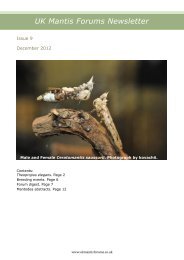UK mantis forums newsletter
UK mantis forums newsletter
UK mantis forums newsletter
Create successful ePaper yourself
Turn your PDF publications into a flip-book with our unique Google optimized e-Paper software.
<strong>UK</strong>MF Newsletter issue 6<br />
Mantodea Abstracts, November 2010 – December<br />
2011<br />
Compiled by Gillian Higgins<br />
The abstracts for scientific papers related to the study of <strong>mantis</strong>es are listed below.<br />
Allen, L. E., Barry, K. L., Holwell, G. I. (2011), Mate Location and Antennal Morphology in<br />
the Praying Mantid Hierodula majuscula. Australian Journal of Entomology. 2011, doi:<br />
10.1111/j.1440-6055.2011.00843.<br />
Abstract: Many sensory modes can be exploited to determine the location of potential<br />
mates. In insects, long-distance location primarily involves chemical or acoustic cues,<br />
whereas short-distance communication mainly utilises visual or tactile cues. The structural<br />
complexity of the environment may influence the transmission of information, and therefore,<br />
it is common to see multiple sensory modes employed to increase the likelihood of accurate<br />
mate location. Praying mantids are known to use airborne chemicals for long-distance<br />
location and visual cues in close proximity. This study examined which types of cues are<br />
used for mate location in an unstudied species, Hierodula majuscula, from Queensland,<br />
Australia. The timing of female pheromone emission during ‘calling’ periods reached a peak<br />
at 3:00 h, with the majority of females assuming a calling posture at this time. Scanning<br />
electron microscopy was used to confirm the presence of basiconic sensilla (used for<br />
chemical reception) on male antennae, and males successfully responded to female<br />
chemical cues and subsequently located potential mates. Males were not as successful at<br />
finding females when restricted to using visual cues.<br />
Allen, L. E., Barry, K. L., Holwell, G. I., Herberstein, M. E., Perceived Risk of Sperm<br />
Competition Affects Juvenile Development and Ejaculate Expenditure in Male Praying<br />
Mantids. Animal Behaviour, 2011, 82 (5): 1201-1206,<br />
Abstract: Sperm competition occurs when a female mates with more than one male, and<br />
the sperm of those males compete directly over fertilizing her eggs. In polyandrous animals,<br />
males can respond to the perceived risk of sperm competition by flexibly adjusting aspects of<br />
their development and reproductive investment. In high-risk scenarios we might expect<br />
males to accelerate development so as to mature quickly and locate receptive females first<br />
and/or transfer more sperm so as to outcompete rival sperm. We examined these<br />
predictions using the false garden mantid, Pseudo<strong>mantis</strong> albofimbriata, a medium-sized<br />
praying mantid found on the east coast of Australia. Males are less than half the mass of<br />
females. Sexual cannibalism occurs in up to 40% of interactions, highlighting the importance<br />
of investing optimally in reproductive opportunities for males. We housed juvenile males in<br />
two operational sex ratio treatments: three males, one female (high risk of sperm<br />
competition) and one male, three females (low risk). We found no evidence of accelerated<br />
development in the high-risk group; instead, high-risk males took longer to mature. Possibly,<br />
males exposed to a higher risk of sperm competition delay maturity in order to invest in<br />
testes development and sperm production. We also found that males reared in the high-risk<br />
treatment transferred significantly more sperm than males reared in the low-risk treatment,<br />
providing evidence of strategic ejaculation in male P. albofimbriata. This is the first study<br />
demonstrating a male response to the perceived risk of sperm competition via delayed<br />
development and increased ejaculate investment in praying mantids.<br />
25<br />
www.uk<strong>mantis</strong><strong>forums</strong>.co.uk




